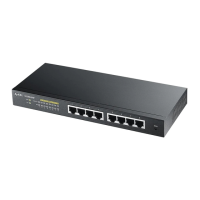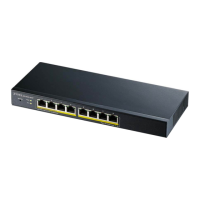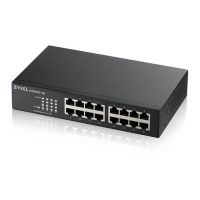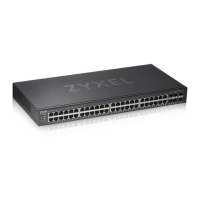Chapter 49 Switching
GS1350 Series User’s Guide
344
49.2 Link Aggregation
This section shows you how to logically aggregate physical links to form one logical, higher-bandwidth
link.
Link aggregation (trunking) is the grouping of physical ports into one logical higher-capacity link. You
may want to trunk ports if for example, it is cheaper to use multiple lower-speed links than to under-utilize
a high-speed, but more costly, single-port link. However, the more ports you aggregate then the fewer
available ports you have. A trunk group is one logical link containing multiple ports.
The beginning port of each trunk group must be physically connected to form a trunk group.
49.2.1 What You Can Do
• Use the Link Aggregation Status screen (Section 49.3 on page 344) to view ports you have configured
to be in the trunk group, ports that are currently transmitting data as one logical link in the trunk group
and so on.
• Use the Link Aggregation Setting screen (Section 49.4 on page 345) to configure to enable static link
aggregation.
• Use the Link Aggregation Control Protocol screen (Section 49.5 on page 347) to enable Link
Aggregation Control Protocol (LACP).
49.3 Link Aggregation Status
Use the Link Aggregation Status screen to view ports you have configured to be in the trunk group, ports
that are currently transmitting data as one logical link in the trunk group and so on.
Click Switching > Link Aggregation > Link Aggregation Status in the navigation panel.
Broadcast (pkt/s) Select this option and specify how many broadcast packets the port receives per second.
Multicast (pkt/s) Select this option and specify how many multicast packets the port receives per second.
DLF (pkt/s) Select this option and specify how many destination lookup failure (DLF) packets the port
receives per second.
Apply Click Apply to save your changes to the Switch’s run-time memory. The Switch loses these
changes if it is turned off or loses power, so use the Save link on the top navigation panel to
save your changes to the non-volatile memory when you are done configuring.
Cancel Click Cancel to reset the fields.
Table 171 Switching > Broadcast Storm Control (continued)
LABEL DESCRIPTION

